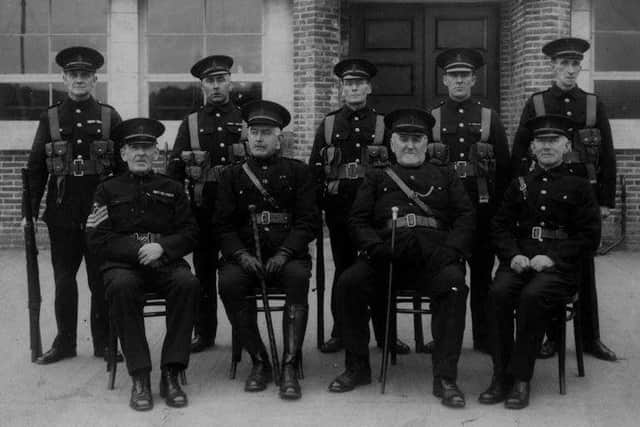Loyalists’ houses attacked: B Special is murdered (1922)
and live on Freeview channel 276
As a result, a B Special named Samuel Milligan, aged 18, was murdered in the presence of his aged father, and a local shoemaker named Owen Magill, also aged 18, assumed to be one of the attackers, was shot dead.
The houses of three Protestant farmers named William Davidson, Stewart Davidson and David Milligan, of Clonaneese Glebe, were attacked by many armed men. The residents replied to the fire and a fierce encounter ensued, during which Samuel Milligan, aged 18, was struck by a bullet which ricochetted from the woodwork of a window, and died before medical assistance could be procured.
Advertisement
Hide AdAdvertisement
Hide AdWhen the fighting ceased, the body of Owen Magill, of Factory Row, Castlecaulfield, a shoemaker, was found about 20 yards from Milligan’s residence. He had two bullet wounds in the region of the heart. Beside him was found a double-barrelled shotgun with two spent cartridges in the breech, while in his pockets were two Mills’s bombs and 17 rounds of buckshot cartridges.


The News Letter reported that it was believed that the intention of the raiders was to shoot special constable Samuel J Davidson, of the Dungannon Mobile Platoon, who was on leave and at his father’s house when the raiders arrived. They knocked at the door and asked whether the constable was at home. Davidson asked the men who they were, and they replied “B men”. Davidson immediately fired on them and, after several shots, the men fled.
The Dungannon Specials, hearing the shooting, immediately motored to Castlecaulfield, but apparently the raiders had heard the noise of the Crossley as, on their arrival, no trace of the murderers could be found.
The News Letter declared: “Excitement in the village, which is predominantly Protestant, is at fever heat. The Castlecaulfield B Constabulary were on patrol duty on Sunday night, and learning that there was a muster of armed men at Aughintober, proceeded in that direction. Apparently this was a ruse to draw the patrol away from the village.”
Advertisement
Hide AdAdvertisement
Hide AdIt was also reported that large forces of Special Constabulary and RUC had conducted “vigorous searches throughout a wide area”.
Vigorous search for incendiaries after Desertmartin mill fire
On Sunday night (May 6, 1922) about 11.30 pm a fire believed to be another Sinn Fein act of incendiarism, broke out in the corn and flax mills owned by Mr John Rodgers, JP, at Annagh, a short distance from the village of Desertmartin in Co Londonderry.
Despite the fact that the alarm was at once raised the fire had “got such a hold that it was apparent from the first that the buildings were doomed”, and a few hours afterwards nothing remained but the charred walls and twisted remains of the machinery.
Advertisement
Hide AdAdvertisement
Hide AdThe B Specials from Desertmartin and the platoon of ‘A’ Constabulary from Magherafelt were early on the scene but their efforts to salvage any portion of the buildings were in vain. Subsequently the platoon from Maghera arrived and the police made a search of several houses but no arrests were made.
Outbursts of firing could be heard in the district but it had not been ascertained whether the police were fired on or what exactly took place.
The house of Francis Daley, Longfield, Desertmartin, was observed to be on fire later. The roof fell in and destroyed the interior of the house. The News Letter noted: “Some time ago another mill was burned in the district.
Railway buffers stolen at Newry harbour
At Newry on the morning of May 7, shortly after two o’clock, Harbour-Constable Fred Walsh was held up by an armed man, and under cover of a revolver, put into a hut, where he was kept a prisoner for several hours.
Advertisement
Hide AdAdvertisement
Hide AdMeanwhile a gang of armed men were engaged in the work of forcibly removing buffers from railway waggons lying on the siding at the basin. In all 12 buffers were taken off five waggons.
At about four o’clock the man who had closed Harbour-Constable Walsh in the hut returned, and ordered him not to leave for an hour, as “ it would be worse for him”. Shortly afterwards a motor car came on the scene, picked up the gang and passed along the quays.
About half-past four Harbour-Constable Walsh left the hut, and later on reported the occurrence to the Harbour-Master.
The News Letter remarked: “It is believed that the railway buffers were taken for use in the manufacture of Sinn Fein land mines. A railway buffer, it will be remembered, formed part of the land mine which was discovered on the road in the vicinity of the Newry Workhouse on the 27th ult.”
Startling seizures by Southern Bolshevists
Advertisement
Hide AdAdvertisement
Hide AdThe Tipperary, Bansha, Carrick-on-Suir, Clonmel, Kilmallock, Knockloug, and Mallow branches of the well-known firm of Cleeve’s Brothers, condensed milk manufacturers, had been taken over by parties of Irish Bolshevists in the name of the workers, reported the News Letter.
“Red flags have been hoisted, and a proclamation issued by the loaders ends with the phrase: ‘Long live the sovereign people’. This document states that the factories are to be worked in the interests of the community.”
At one of the factories the local secretary, of the Transport Workers’ Union had been appointed manager by “the so-called workers”.
Comment Guidelines
National World encourages reader discussion on our stories. User feedback, insights and back-and-forth exchanges add a rich layer of context to reporting. Please review our Community Guidelines before commenting.